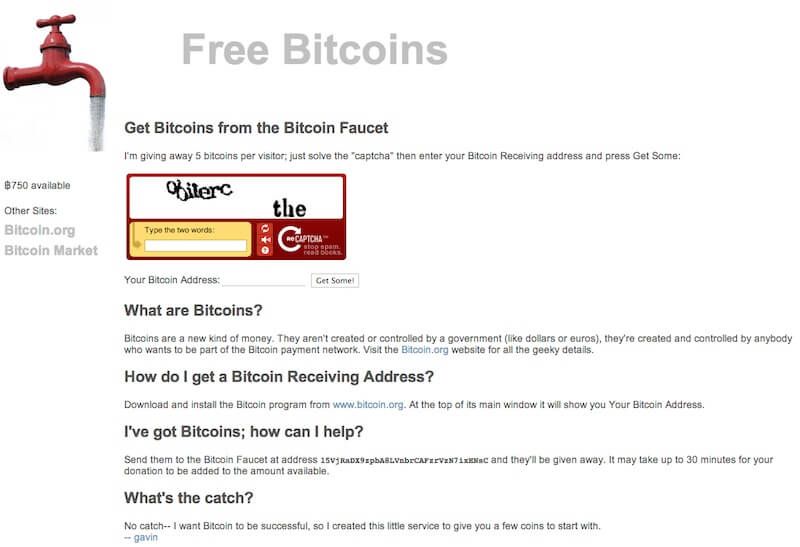What is a crypto faucet and how does it work?
Learn what crypto faucets are, how they function, and how you can earn small amounts of cryptocurrency without any financial investment.
By Corey Barchat

Since the launch of Bitcoin in 2009, the crypto ecosystem has accumulated a market capitalization of over $2 trillion, creating plenty of opportunities to earn and invest in digital assets.
Newcomers, however, may face several challenges when entering the crypto space.
Technical knowledge can be intimidating for some users, while others may face the seemingly insurmountable barrier of the financial investment involved. This is where crypto faucets come into play, offering an easy entry point for beginners.
But what are crypto faucets and how do they function to reward users?
In this article, we explore the concept of crypto faucets, how they work, the different types available, as well as best practices for getting the most out of these platforms.
What is a Crypto Faucet?
A crypto faucet is an online platform or application that rewards users with small amounts of cryptocurrency in exchange for performing basic tasks. These crypto-dispensing tasks can range from solving captchas, clicking on ads, watching videos, participating in surveys, and completing other microtasks.
You may be wondering where the term "faucet" comes from. Well, the premise of these platforms is to "drip" small amounts of cryptocurrency, much like how a leaky faucet drips water little by little.
For many users, crypto faucets serve as an accessible way to dip their toes into the pool of digital currency without needing to buy crypto with fiat money. Over time, as users accumulate small rewards, they can transfer these crypto earnings to their personal wallets at any time, trade them, or save them for future investment.
The origin of crypto faucets
Some of the earliest crypto faucets date back to 2010, shortly after the launch of Bitcoin, the first cryptocurrency.
The very first BTC faucet was created by Bitcoin developer Gavin Andresen as a way to introduce more people to the concepts of Bitcoin and blockchain technology. At that time, Bitcoin was not as well-known or valuable as it is today, so faucets served as a way to increase awareness and adoption.

His Bitcoin faucet gave away a generous 5 BTC per user for the simple task of solving a captcha. At the time, Bitcoin had little monetary value. For reference, five bitcoins would be worth over $300,000 USD today! In 2024, however, the amount distributed by faucets is much smaller, but the concept remains the same—introducing users to crypto in a low-risk, low-reward manner.
How does a Crypto Faucet work?
Crypto faucets operate on a basic principle: Users complete tasks or perform actions, and in return, they are rewarded with small amounts of free cryptocurrency. Here's how the process generally works:
- Sign up or log in to a faucet website or app.
- Complete simple tasks such as solving captchas, watching ads, playing games, and answering surveys or quizzes.
- Accumulate small rewards of cryptocurrency for each task completed. For a Bitcoin faucet, these rewards are usually in the form of satoshis (Bitcoin's smallest unit), while other cryptocurrency faucets reward users with fractions of free tokens.
- Once you hit the minimum withdrawal limit, you are free to transfer your earnings to a personal crypto wallet. However, users should be aware of any fees incurred during withdrawal to a wallet.
Not every crypto faucet will function in the same manner, so exact steps may vary. Some faucets are ad-supported, which means they generate revenue from advertisers and share a small portion of this income with users. Others might rely on affiliate programs or partnerships to sustain operations.
In all instances, the bottom line is that users exchange their time and attention for a small crypto payout.
Types of Crypto Faucets
Crypto faucets come in various forms, depending on the type of cryptocurrency offered and the activities involved. Here are some of the most common types:
Bitcoin faucets
Bitcoin faucets are the most popular and widely known type of crypto faucet. These platforms give users small amounts of Bitcoin—typically in satoshis, the smallest BTC fractional unit—as a reward for completing simple tasks.

Given Bitcoin's prominence as the leading cryptocurrency, Bitcoin faucets often attract a large number of users, even though the rewards are quite small compared to Bitcoin's market value, as well as previous rewards.
Ethereum faucets
Alongside the rise of Ethereum in NFTs and DeFi, and its status as the second-largest cryptocurrency by market cap, Ethereum faucets have also gained popularity. These faucets reward users with Ether (ETH) or smaller units known as gwei. Ethereum faucets often target users who are interested in learning about Ethereum's smart contract functionality or decentralized applications (dApps).
Altcoin faucets
In addition to Bitcoin and Ethereum, there are also altcoin faucets that dispense smaller, lesser-known cryptocurrencies like Litecoin (LTC), Ripple (XRP), Dogecoin (DOGE), or Monero (XMR). These faucets are more suitable for users who want to diversify their crypto holdings or explore different blockchain projects. Since certain altcoins have lower transaction fees than Bitcoin and Ethereum, they can be a more practical and cost-effective option for faucet users.
Microtask-based faucets
Some faucets require users to complete microtasks—small, simple activities that benefit the faucet operator or advertiser. Microtask-based faucets can be appealing because they allow users to earn cryptocurrency for performing tasks that are often quick and easy to complete.
Microtask activities that offer rewards include watching ads, completing surveys, or signing up for offers. Advertisers pay the faucet operator for the exposure, and in return, users earn crypto rewards for interacting with the ads.
Gaming faucets
Gaming faucets are as simple as they sound. Players play games—often with basic interfaces or simple tasks—where they can earn crypto rewards for achieving certain goals or milestones. These games may range from simple puzzle-solving tasks to more complex blockchain-based games like CryptoKitties or Axie Infinity, where in-game assets can have real-world value.
Other types of crypto faucets
There are also cryptocurrency faucets tailored to specific use cases or industries. For instance, some faucets are dedicated to promoting a particular crypto project, while others may focus on raising awareness for social causes, allowing users to earn crypto in return for performing charitable actions.
Benefits of using a Crypto Faucet
Crypto faucets offer a range of advantages, particularly for newcomers to the crypto world:
Easy entry into cryptocurrency
For users who are new to crypto, faucets can provide an introductory way to start collecting digital currencies. Regardless of experience level and prior knowledge, anyone can participate in faucets and earn rewards.
No financial investment required
One of the biggest draws of crypto faucets is that you don't need to spend any money to participate. All that's required is your time and effort, which makes it a lower risk option for users looking to explore cryptocurrencies without incurring any costs.
Familiarizing users with blockchain technology
In using and exploring crypto faucet platforms, users can get hands-on experience with blockchain technology. Whether it’s creating a wallet, transferring crypto, or learning about blockchain transactions, faucets offer a practical education inside the world of digital assets.
Portfolio diversification
A crypto faucet offers a simple way to diversify your portfolio by earning a variety of cryptocurrencies, not just Bitcoin or Ethereum. Participating in multiple faucets allows users to accumulate small amounts of altcoins they would otherwise ignore, helping to provide exposure to different blockchain projects without direct investment.
Increased crypto adoption
Faucets contribute to wider cryptocurrency adoption by incentivizing users to join the ecosystem. As users become more familiar with cryptocurrencies, they may become more likely to engage with other aspects of blockchain technology.
Drawbacks of Crypto Faucets
While crypto faucets have their advantages, they are not without their downsides. Users should be aware of the potential drawbacks before dedicating their time and effort:
Low earnings potential
Though faucets can provide free crypto, they are not a reliable source of income. The reason for this is increasingly smaller rewards for completing tasks—sometimes just fractions of a penny's worth of cryptocurrency. While users in the past were able to earn significant amounts of Bitcoin, today they are likely to only accumulate tiny amounts over time.
Time-consuming activities
Because of the low payouts, faucets can become time-consuming and cause ad fatigue in users. Completing tasks or watching ads repeatedly for small rewards can become frustrating and tiresome, especially when compared to the time investment required. For most users, faucets can be better utilized as a learning tool rather than a way to generate substantial earnings.
Security and privacy concerns
Some cryptocurrency faucet platforms require users to provide personal information, such as an email address or wallet details. Although this is usually harmless, it may raise privacy concerns for specific individuals. Additionally, there is always a risk that disreputable faucets could expose users to phishing or malware attacks, making user funds vulnerable to loss.
Withdrawal limits
Many faucets have high minimum withdrawal limits, meaning it can take a long time to accumulate enough rewards to make a withdrawal. These limits can be discouraging for users, especially when the payout per task is small. Some faucets may even set withdrawal limits deliberately high to minimize the number of microtransactions they need to process, making it difficult to reach the required threshold in a reasonable amount of time.
Platform longevity
Many crypto faucets rely on advertising revenue to operate. If ad revenue decreases or interest in faucets wanes, these platforms may become unsustainable, reducing their long-term viability. Additionally, declining payouts or limited user engagement can further impact the longevity of faucet platforms, making them a potential waste of time for participants.
FAQs about Crypto Faucets
Are crypto faucets safe?
In general, most well-established crypto faucets are safe to use, but it's important to be cautious. Look for faucets that have legitimate user reviews, transparent payout policies, and no history of security issues. Avoid services that require too much personal information or seem to promise unrealistic rewards.
How to find reputable crypto faucets
To find reputable faucets, you can check online forums, reviews, and creditable crypto community hubs. Look for faucets that have a track record of timely payouts and good user feedback, and avoid faucets that redirect users to suspicious websites and potentially fraudulent platforms.
Are crypto faucets worth it?
While the amount you can earn from a cryptocurrency faucet is typically very small, it varies by platform. Users may be able to earn anywhere from a few cents to a couple of dollars' worth of cryptocurrency per week, depending on the tasks and the faucet's payout structure.
Do crypto faucets have fees?
Most crypto faucets do not charge users any fees for participating. However, when users reach the withdrawal threshold, some faucets may charge a transaction fee to send the earned cryptocurrency to the user’s wallet. These fees are usually small but can eat into the already minimal earnings if the faucet requires frequent withdrawals.
Can you use multiple faucets at once?
Yes, you can use multiple crypto faucets simultaneously. In fact, some strategies to maximize earnings may include signing up for several faucets and completing tasks on different platforms. Just make sure each faucet is reputable and secure, and consider using a separate email to manage multiple accounts efficiently and securely.
What are some best practices for maximizing crypto faucet rewards?
To get the most out of crypto faucets, here are some factors worth considering:
- Join Multiple Faucets: To increase your earnings, consider signing up for several reputable faucets.
- Set a Routine: Regularly check your faucets and complete tasks on a consistent basis to maximize your rewards.
- Use a Dedicated Email: For security and privacy reasons, use a separate email address for each crypto faucet to avoid scams, spam, and potential security risks.
Always verify the legitimacy of a faucet before using it to avoid potential scams or security risks. Results may vary, and substantial financial gain is never guaranteed.
Get started with Cryptocurrency Faucets
Ready to explore cryptocurrency faucets and start earning your first crypto rewards? One way to begin is by setting up a wallet and purchasing a small amount of cryptocurrency to understand the process better.
MoonPay makes it easy to buy Bitcoin (BTC), Ethereum (ETH), and other cryptocurrencies in larger amounts than can be earned via faucets. Owning cryptocurrency and familiarizing yourself with its usage can give you the foundation you need to get started with faucets and other opportunities.






